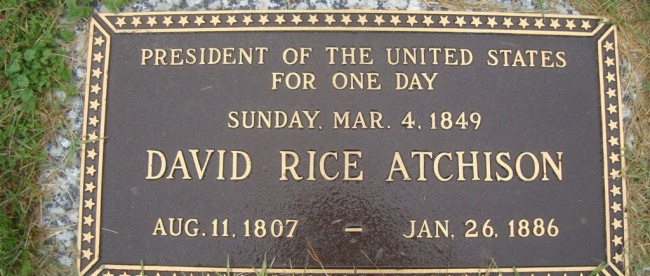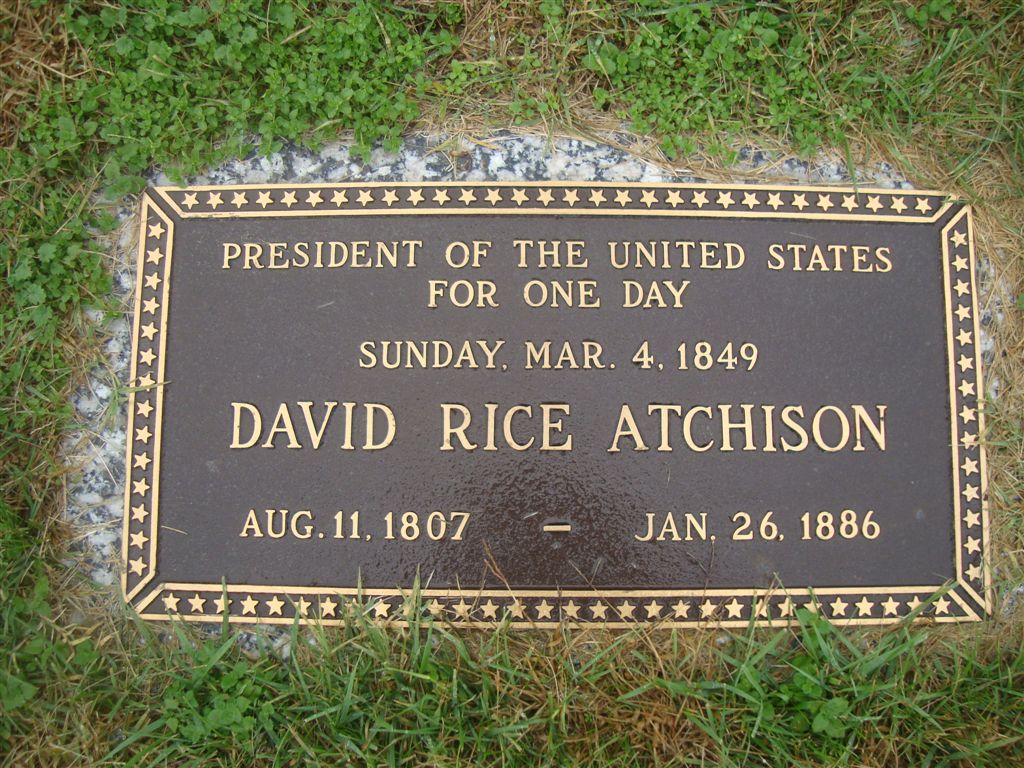The Vice:President


The gravestone of David Rice Atchison, pictured above, says that he was the “President of the United States for One Day.” If you’re not familiar with the story there, it’s basically this: James K. Polk’s term as President of the United States ended on March 3, 1849, and his successor, Zachary Taylor, wouldn’t take the oath of office on the following day because it was a Sunday. So on March 4, 1849, Polk was no longer President, but depending on who you ask, neither was Taylor. Some believe that a Senator named David Rice Atchison filled that one-day gap, because the law at the time provided that the President pro tempore became President if the regular guy (and his VP) were gone for some reason.
A good story — but it’s widely believed to be simply incorrect. Most historians believe that Taylor was the President on that date, as the President-Elect ascends to the Presidency even if he doesn’t take the oath of office. But even if you don’t, that doesn’t make Atchison the President. As the Senate’s website points out, “[Atchison’s] Senate term also expired at noon on March 4, thereby denying him the chance to become president. When the Senate of the new Congress convened the following day to allow new senators and the vice president to take the oath of office, with no president pro tempore, the secretary of the Senate called members to order.” As a result, a minority of historians believe that there was simply no president that day. But there’s almost 100% agreement among the history experts that David Rice Atchison was never the President — not even close.
On the other hand, they all agree that Dick Cheney kind of, sort of, was.
The reason: polyps.
Before taking office in 2000, President George W. Bush had undergone a pair of colonoscopies which turned up some benign polyps. As a result, his doctors — in line with best practices — advised him to have follow-up colonoscopies every few years thereafter. That came to pass in 2002, when Bush was to undergo the straightforward, common procedure — but it required his sedation. Just prior to the procedure, Bush invoked Section 3 of the 25th Amendment, which allows the President to, temporarily, vest his powers in the Vice President as “Acting President.” Bush told the press that he was “the first president to have done so under this type of procedure and/or physical examination,” and “did so because we’re at war and I just want to be super-cautious.” (The odd locution — “under this type of procedure” — was because Ronald Reagan may have evoked Section 3 before undergoing colon cancer surgery, although that was a bit ambiguous at the time.)
It wasn’t the last time, though. In 2007, Bush underwent a similar procedure and once again temporarily handed power over to Cheney. Both times, Dick Cheney’s time as the surrogate President lasted from about 7 AM to 9:30 AM; the procedures took about 20 to 30 minutes, and Bush only reclaimed power after being sure that the sedatives had worn off.
Cheney wasn’t “President for a Day” (or even “President for Approximately Five Hours over Two Terms”), but simply “Acting President” per the text of the Amendment. (He never took the oath of office, and correctly does not appear on the list of people who have served as President.) And he didn’t do much during his two stints in the role — the press is silent as to his goings-on during his pair of nearly two and a half hour terms as perhaps the most powerful person in the world. But at least he was awake for it. The same can’t be said for Atchison in his one day of not-quite-President: he told the St. Louis Globe-Democrat (via Wikipedia) that he slept through most of it, citing some late nights in the Senate the week prior.
Bonus fact: The 25th Amendment wasn’t adopted until 1967, and before that point, there was no mechanism for installing a new Vice President if the existing one left office (or ascended to the Presidency). But when John F. Kennedy was assassinated in 1963, his successor, Lyndon B. Johnson, had a checkered health history — a multiple pack-a-day smoker less than a decade before, LBJ suffered a near-fatal heart attack in 1955. Johnson’s assumption of JFK’s term meant he was a health risk without a VP as a safety net, so Congress passed the 25th Amendment to fix the issue going forward, and the states thereafter ratified it.
From the Archives: The President’s Pants: A PG-13 phone call from LBJ.
Take the Quiz: Can you name the Presidents of the US that were previously Vice Presidents? (Dick Cheney didn’t make the list.)
Related: “A Country Without A Vice President: Fascinating Stories of The 16 Times When The US Was Missing Its Veep!” by Robert Antle. Seven reviews averaging 4.6 stars, but the title probably doesn’t deserve the exclamation mark.
